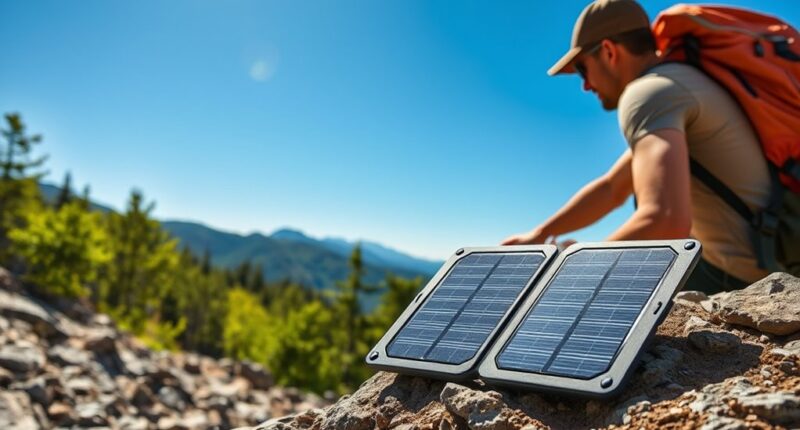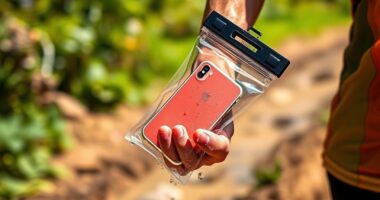When choosing the best solar phone chargers for trail adventures, I look for high-capacity models with fast-charging options, multiple ports, and durable, weather-resistant designs. Features like built-in flashlights, wireless charging, and additional tools are a plus. The top picks also have efficient solar panels—though recharging via sunlight is slow—so USB charging remains key. To discover the ideal options for off-grid power, keep exploring further.
Key Takeaways
- Prioritize high-capacity, rugged models with IP67 or IP65 ratings for durability in outdoor trail conditions.
- Choose solar chargers with efficient monocrystalline panels and larger surface areas for better sunlight conversion.
- Ensure multiple charging ports (USB-A, USB-C, wireless) to power various devices simultaneously off-grid.
- Opt for portable, lightweight designs with built-in handles or carabiners for easy outdoor attachment and transport.
- Select chargers with fast charging (PD 20W) and emergency features like LED flashlights and radios for versatile trail use.
Power Bank Solar Charger 42800mAh Portable External Battery Pack
If you’re looking for a reliable power source for extended outdoor adventures, the Power Bank Solar Charger 42800mAh is an excellent choice. With its high-capacity lithium polymer battery, it can recharge your devices multiple times, like your iPhone three times over. Compact and rugged, it’s built to withstand tough conditions—water, dust, and drops won’t slow it down. It features two USB ports with fast charging support, plus a bright LED flashlight for nighttime use. While solar charging is slow and mainly for emergencies, this power bank provides dependable backup power when you need it most, making it perfect for camping, hiking, or festivals off the grid.
Best For: outdoor enthusiasts, campers, hikers, and festival-goers seeking a rugged, high-capacity backup power source for extended adventures.
Pros:
- Large 42800mAh capacity allows multiple device recharges, perfect for long outdoor trips
- Rugged, waterproof, dust-proof, and drop-proof construction suitable for harsh environments
- Supports fast charging protocols with dual USB ports and includes a bright LED flashlight for nighttime use
Cons:
- Solar charging is slow and mainly suitable for emergency or trickle charging purposes
- The device can be heavy and bulky, which may be inconvenient for portability
- Some users report hardware issues like damaged USB-C ports or inaccurate power meters
Solar Power Bank, 38800mAh Portable Solar Charger with Type-C & LED Flashlights
For outdoor enthusiasts who need reliable power on the go, the Solar Power Bank with 38,800mAh capacity stands out as an excellent choice. Its durable, waterproof, and dustproof design makes it perfect for camping, hiking, or any off-grid adventure. It features multiple outputs, including Type-C and USB ports, allowing me to charge several devices simultaneously. The built-in LED flashlights with steady, SOS, and strobe modes add safety during emergencies. Plus, its compact size and lightweight design make it easy to carry. While solar charging is slow, recharging via USB is quick and efficient, ensuring I stay powered no matter where I am.
Best For: outdoor enthusiasts, campers, and travelers who need a reliable, portable power source for multiple devices in outdoor or off-grid environments.
Pros:
- High-capacity 38,800mAh battery ensures long-lasting power for multiple devices.
- Waterproof, dustproof, and durable design suitable for rugged outdoor use.
- Multiple charging options including solar and USB, along with convenient features like LED flashlights and a built-in compass.
Cons:
- Solar charging is slow and mainly provides a trickle current, so it’s not ideal for quick recharging.
- Relatively heavy at 8.7 ounces, which may be less convenient for ultra-light backpackers.
- Limited information on fast-charging capabilities for devices beyond basic USB output.
BLAVOR Solar Charger Power Bank 10,000mAh with USB C and Solar Panel
The BLAVOR Solar Charger Power Bank 10,000mAh stands out as a reliable choice for outdoor enthusiasts who need a durable, safety-conscious backup power source. Its rugged design features flame-retardant ABS and PC outer shells, making it tough enough for camping or hiking. With IPX5 waterproof, dustproof, and shockproof ratings, it’s built to handle rough conditions. Equipped with USB-C fast charging up to 20W, it can power multiple devices simultaneously, including wireless charging. Although the solar panel offers only supplemental charging—about 10-20% after a full day in the sun—it’s perfect for emergency use when you’re off-grid.
Best For: outdoor enthusiasts, campers, and travelers seeking a durable, reliable power bank with emergency solar backup.
Pros:
- Rugged, durable design with flame-retardant ABS and PC outer shell suitable for outdoor conditions
- Supports fast charging up to 20W via USB-C, charging multiple devices including wireless charging simultaneously
- IPX5 waterproof, dustproof, and shockproof, making it highly resistant to harsh environments
Cons:
- Solar panel provides only a trickle charge (10-20% after full sun), not suitable for full recharging in the wild
- Some users find the included USB-C cable to be of low quality and less durable
- The compass feature is not highly accurate, limiting its usefulness for navigation
Solar-Charger Power Bank 49800mAh with LED Flashlight and 15W USB C Fast Charge
When heading off the grid, having a reliable power source is essential, especially one that combines high capacity with fast charging capabilities. I found this solar power bank with 49,800mAh perfect for charging multiple devices multiple times. It’s certified safe, with protections against over-voltage, over-current, and short circuits. It supports fast 15W USB-C charging and can be recharged via sunlight or a USB adapter. Its rugged, waterproof design includes a built-in LED flashlight with SOS and strobe modes. Compact and durable, it’s ideal for camping, hiking, or emergencies. Plus, the LED indicators make it easy to monitor remaining power, ensuring you stay connected off the grid.
Best For: outdoor enthusiasts, travelers, and emergency preparedness users needing a high-capacity, rugged, and versatile power bank with fast charging and solar recharging options.
Pros:
- Large 49,800mAh capacity capable of charging multiple devices multiple times
- Rugged, waterproof, dustproof design with built-in LED flashlight and SOS/strobe modes
- Supports fast 15W USB-C charging and multiple device compatibility
Cons:
- The solar panel provides slow charging, making USB charging the primary method
- Fragile plastic post attachment may break under stress, requiring reinforcement
- Slightly bulky at 5.7 x 3 x 0.7 inches and 1.06 pounds, which may affect portability for some users
ERRBBIC Solar Charger Power Bank 49800mAh
If you need a reliable power source to keep your devices charged during outdoor adventures, the ERRBBIC Solar Charger Power Bank 49800mAh stands out with its massive capacity and fast charging capabilities. It can charge an iPhone 16 up to 10 times and supports simultaneous charging of six devices, including smartphones, tablets, and smartwatches. With built-in cables for Type-C, Lightning, Micro USB, and USB-A, plus external ports, it eliminates extra cords. The 15W wireless charging feature allows quick, cordless recharging. Rugged, waterproof, and equipped with emergency tools like a flashlight and rescue modes, it’s perfect for surviving off-grid adventures.
Best For: outdoor enthusiasts, travelers, and anyone needing a reliable, high-capacity power source for multiple devices in rugged environments.
Pros:
- Massive 49,800mAh capacity supports multiple charges for smartphones, tablets, and devices simultaneously
- Rugged, waterproof, shockproof, and dustproof design ideal for outdoor use
- Built-in cables and wireless charging for convenient, cord-free device recharging
Cons:
- Heavy and bulky, which may be less portable for everyday carry
- Longer charging times due to high capacity, especially when using solar panel backup
- Higher price point compared to smaller or less durable power banks
Hiluckey Solar Charger 25000mAh Portable Power Bank with Solar Panels
For outdoor enthusiasts seeking reliable power in remote settings, the Hiluckey Solar Charger 25000mAh stands out with its high-capacity design and rugged construction. It features four foldable, efficient solar panels, making it ideal for emergency recharging. The device supports fast charging with a USB-C port and multiple USB-A ports for simultaneous device charging. Its weather-resistant plastic casing is built to withstand rain, snow, and drops, while the bright flashlight offers up to 135 feet of illumination. Although solar recharging is slow and primarily for emergencies, it’s a dependable backup for keeping your phone, tablet, or outdoor gear powered during long adventures.
Best For: outdoor enthusiasts, hikers, and travelers who need a durable, high-capacity power bank for emergency recharging in remote or rugged environments.
Pros:
- High-capacity 25,000mAh battery capable of charging smartphones 6-8 times and tablets about 2.5 times
- Rugged, weather-resistant design resistant to rain, snow, drops, and overheating
- Four foldable, efficient solar panels for emergency recharging, with fast charging via USB-C and multiple USB-A ports
Cons:
- Solar recharging is slow, taking up to 50 hours under optimal sunlight for a full recharge
- Heavy and bulky, which may be inconvenient for some users to carry during extended outdoor activities
- Occasional customer reports of decreased solar efficiency or device failure over time, often due to misuse or environmental factors
Solar Power Bank 39800mAh with Fast Charging and Built-in Flashlight
The Solar Power Bank 39800mAh with Fast Charging and Built-in Flashlight stands out as an ideal choice for outdoor enthusiasts who need reliable, high-capacity power on the go. With nearly 40,000mAh, it can keep your devices charged during extended trips. Its dual USB ports and Type-C support quick, versatile charging options. Made from durable, IP65-rated materials, it’s built to withstand dust, shocks, and water. The integrated LED flashlight offers three modes—steady, SOS, and strobe—perfect for emergencies. Plus, a portable compass helps with navigation. It recharges via solar or USB, ensuring you stay powered even off-grid.
Best For: outdoor adventurers and travelers who need a reliable, high-capacity power source with emergency features.
Pros:
- High capacity of 39800mAh ensures extended device usage during trips.
- Durable construction with IP65 waterproof, dustproof, and shockproof protection.
- Built-in LED flashlight with multiple modes and included portable compass for outdoor convenience.
Cons:
- Solar charging efficiency depends on environmental conditions and may be slow.
- Bulkier size compared to smaller portable chargers, which might impact portability for some users.
- Charging via solar is less reliable than USB, requiring additional time in low-light situations.
Solar Power Bank 20,000mAh with 4 Cables and 3 Ports
Designed for outdoor enthusiasts, the Solar Power Bank 20,000mAh with 4 cables and 3 ports offers reliable, multi-device charging in rugged conditions. Its water-resistant, shock-resistant, and dustproof design makes it perfect for camping and hiking. Equipped with a carabiner, compass, and a dual LED flashlight (steady, SOS, strobe), it’s built for versatility. With four cables and three ports, it supports fast charging for smartphones, tablets, and other USB devices simultaneously. Made from eco-friendly materials, it’s durable and safe, certified CE, FCC, and RoHS. Whether recharged via solar or outlet, it’s a dependable power source when you’re off the grid.
Best For: outdoor enthusiasts and adventurers needing reliable, multi-device charging in rugged environments.
Pros:
- Waterproof, shockproof, and dustproof design ideal for outdoor activities like camping and hiking.
- Supports fast charging for multiple devices simultaneously with 4 cables and 3 ports.
- Eco-friendly materials and certified safety standards ensure durability and reliability.
Cons:
- Heavy at 8.8 ounces, which might be less convenient for ultralight backpackers.
- Limited to 20,000mAh capacity, which may require multiple charges for high-demand devices.
- The solar charging speed can be slow depending on sunlight conditions.
Emergency Radio & 22000mAh Solar Power Bank with FM NOAA Weather Radio, Hand Crank, Bluetooth, Wireless Charging, SOS Flashlight
When you’re out in the wild and need a reliable power source, this emergency radio and 22,000mAh solar power bank stands out as a top choice. It combines survival tools like an FM/NOAA weather radio, SOS flashlight, and hand crank with versatile charging options, including wireless charging and fast USB-C. The built-in battery supports hours of radio listening, device charging, and lighting. It’s waterproof, dustproof, and shockproof, making it perfect for outdoor adventures. Whether in emergencies or camping, this device keeps you connected and safe, offering peace of mind with multiple power methods and emergency features all in a compact, durable design.
Best For: outdoor enthusiasts, campers, and emergency preparedness individuals seeking a durable, multi-functional power source with survival features.
Pros:
- Combines multiple survival tools including FM/NOAA weather radio, SOS flashlight, and hand crank for versatile emergency use
- Supports fast charging via USB-C and wireless charging compatible with popular smartphones
- Waterproof, dustproof, and shockproof design ideal for outdoor environments and harsh conditions
Cons:
- Slightly heavier and bulkier than standard power banks, which may affect portability for some users
- Solar charging efficiency can vary depending on sunlight availability and conditions
- Higher price point compared to basic power banks without emergency features
Solar Power Bank 38800mAh with 4 Solar Panels
If you’re planning extended outdoor adventures where reliable power is essential, the Solar Power Bank 38800mAh with 4 Solar Panels stands out as an excellent option. Its large capacity can charge smartphones 6–7 times and tablets 3–4 times, making it perfect for off-grid use. It features multiple ports, including USB-A and USB-C, for simultaneous device charging, with fast 18W charging via USB-C. The foldable solar panels increase sunlight capture, though solar recharging is slow and supplemental. Built with rugged, waterproof, and fire-resistant materials, it’s durable enough for tough conditions. Plus, the integrated LED flashlight adds emergency versatility, making it a reliable companion for extended outdoor adventures.
Best For: outdoor enthusiasts, travelers, and emergency preppers seeking a durable, high-capacity power bank with solar recharging and multiple device charging options.
Pros:
- Large 38,800mAh capacity can charge smartphones 6–7 times and tablets 3–4 times, ideal for extended outdoor use.
- Rugged, waterproof (IP67), and fire-resistant design ensures durability in tough conditions.
- Multiple charging ports including USB-A and USB-C with fast 18W charging support for simultaneous device power-up.
Cons:
- Solar recharging is slow and mainly supplemental, not suitable as the primary power source.
- Real-world output may be around 60-70% of rated capacity due to voltage conversion inefficiencies.
- Charging via solar panels depends heavily on sunlight conditions, affecting recharge speed during outdoor activities.
GOODaaa Power Bank with Wireless Charging, 36000mAh, 15W Fast Charging, Multiple Cables & Inputs, Solar Portable Charger with Flashlights
The GOODaaa Power Bank with Wireless Charging stands out as an excellent choice for outdoor enthusiasts who need reliable, high-capacity power on the go. Its 36,000mAh battery can charge multiple devices repeatedly, supporting both solar and adapter recharging for continuous power. Built-in cables for iOS, Micro USB, USB-C, and USB-A eliminate external cords, while wireless charging works with many popular smartphones. With four ports and the ability to power up to six devices simultaneously, it’s perfect for trail use. Plus, its waterproof, shockproof design and dual LED flashlights make it durable and practical in harsh environments. This power bank truly covers all your off-grid charging needs.
Best For: outdoor enthusiasts and travelers who need a reliable, high-capacity portable power source with multiple charging options and durability for harsh environments.
Pros:
- Large 36,000mAh capacity allows multiple device charges and supports solar recharging for off-grid use.
- Built-in cables and wireless charging simplify device connection, reducing the need for external cords.
- Waterproof, shockproof, and dustproof design with dual LED flashlights makes it highly durable and suitable for outdoor adventures.
Cons:
- The power bank’s size and weight (15.2 ounces) may be less convenient for everyday carry.
- Limited availability of detailed warranty information online could be a concern for some buyers.
- The charging speed, although 15W fast charging, may be slower compared to newer fast-charging standards for certain devices.
Solar Charger Power Bank with 20W Fast Charging, 40000mAh Portable Battery Pack with Built-in Cables and Dual Flashlights
For outdoor enthusiasts seeking reliable power on the trail, this solar charger power bank stands out with its impressive 20W fast charging capability and massive 40,000mAh battery capacity. It’s built from durable, heat-resistant ABS material, making it tough enough for extreme environments. The device features built-in cables for Type-C, iOS, Micro USB, and USB-A, allowing you to charge five devices simultaneously without extra cords. Dual bright flashlights add emergency support, operating up to 30 hours. Plus, the 1.8W solar panel offers supplementary solar charging. Compact and waterproof, it’s an excellent all-in-one power solution for any outdoor adventure.
Best For: outdoor enthusiasts and travelers who need a durable, all-in-one power source for camping, hiking, and emergency situations.
Pros:
- Supports 20W PD fast charging, quickly powering devices like iPhone 15 to 65% in 30 minutes
- Built-in cables for Type-C, iOS, Micro USB, and USB-A allow charging up to five devices simultaneously without extra cords
- IP67 waterproof and dust-proof design, along with dual flashlights operating up to 30 hours, ideal for extreme outdoor conditions
Cons:
- Heavier at 1.17 pounds, which may be less convenient for ultra-light backpackers
- Solar panel provides supplementary charging but may be slow compared to electrical outlets
- Limited color options (Black-orange) may not appeal to all aesthetic preferences
LuminAID Max Quick Inflate Solar Lantern and Phone Charger
When outdoor adventures demand reliable lighting and phone charging, the LuminAID Max Quick Inflate Solar Lantern and Phone Charger stands out with its dual functionality and rugged design. It combines a rechargeable LED lantern that delivers 200 lumens with multiple brightness settings, including Turbo mode, and a built-in 2000mAh battery capable of charging smartphones up to 75-100%. Inflatable to a 6-cube size, it’s lightweight (less than 10 ounces), waterproof (IP67-rated), and shatterproof, making it perfect for camping, emergencies, or outdoor gatherings. Recharging is easy via solar (16-20 hours) or USB (1-2 hours), ensuring you stay powered wherever you go.
Best For: outdoor enthusiasts, campers, and emergency preparedness individuals seeking a portable, durable lantern with charging capabilities.
Pros:
- Combines LED lantern and phone charger in one compact, lightweight device.
- Waterproof, shatterproof, and rugged construction suitable for tough environments.
- Recharges via solar or USB, providing versatile power options and long-lasting light.
Cons:
- Inflating and deflating may take some time and effort for first-time users.
- Limited battery capacity (2000mAh) may require frequent recharging for high usage.
- Brightness settings and charging speed might not meet all heavy-duty or rapid power needs.
Factors to Consider When Choosing Solar Phone Chargers Trail Situations

When choosing a solar phone charger for trail use, I look at a few key factors to make sure it meets my needs. Things like solar panel efficiency, port options, and device compatibility are vital, along with durability and weatherproofing. Speed of charging and power output also matter to keep my devices ready when I need them most.
Solar Panel Efficiency
Choosing a solar phone charger for trail use means paying close attention to panel efficiency, which determines how well the device converts sunlight into usable power. Higher efficiency panels generate more energy in less space, vital when weight and size matter. Monocrystalline panels typically offer efficiencies around 15-20%, outperforming polycrystalline and amorphous options, making them a better choice for limited surface areas. The size and surface area of the panel directly influence how much energy it can produce, especially in outdoor conditions with variable sunlight. Environmental factors like shading, dirt, and weather can reduce efficiency, so positioning the panel at the right angle and orientation toward the sun is essential. Optimizing these factors ensures you get the most power out of your solar charger during your trail adventures.
Port Selection Options
Selecting the right port options on a solar phone charger is essential for ensuring versatile and efficient outdoor charging. Multiple ports, like USB-A, USB-C, Micro USB, and wireless charging pads, let me charge various devices at once, which is *vital* on extended trips. USB-C ports supporting Power Delivery (PD) provide faster charging and higher power transfer, so I can quickly top off my gadgets. Dedicated ports for different connection types eliminate the need for adapters or extra cables, simplifying setup in the field. Some chargers even offer multiple ports, enabling several devices to be charged simultaneously—perfect for group trips. Additionally, ports with safety features like overcurrent and short circuit protection help prevent damage in rugged environments, giving me peace of mind while staying connected off the grid.
Device Compatibility Range
Ensuring your solar charger supports your devices’ specific ports and charging standards is essential for reliable outdoor use. I always check if it has the right port, whether USB-C, Micro USB, Lightning, or wireless charging, to match my gadgets. It’s also important to verify that the charger’s output voltage and current align with my device’s requirements to avoid undercharging or potential damage. If I plan to charge multiple devices, I look for a charger that can handle several simultaneously. Additionally, I consider the power capacity to make certain it meets my needs for longer trips, balancing speed and efficiency. For international trips, I confirm the charger supports various voltage standards and plug types, so I don’t run into compatibility issues wherever I go.
Durability and Weatherproofing
When venturing into the outdoors, durability and weatherproofing are crucial for keeping your solar charger functional amidst unpredictable conditions. Look for chargers with an IP65 rating or higher, ensuring protection against dust, rain, and splashes. Rugged construction, including shockproof and drop-resistant features, helps prevent damage from accidental falls or impacts. Foldable or multi-panel designs increase solar exposure without sacrificing durability, thanks to sturdy casings made from materials like ABS, PC, or silicone rubber, which withstand extreme temperatures, UV rays, and rugged handling. Additionally, reinforced ports and sealed connectors are essential to prevent water ingress and guarantee long-term resilience. These features give you confidence that your charger can handle the challenges of outdoor adventures, keeping your devices powered no matter what weather comes your way.
Charging Speed and Power
To keep your devices powered efficiently during trail adventures, paying attention to charging speed and power output is essential. Higher wattage outputs, like 15W or 20W, enable faster recharging of your devices, saving you time. Fast-charging protocols such as QC 3.0 or Power Delivery (PD) can markedly cut down charging times for compatible gadgets. Since solar charging is slow and intermittent, it’s best used as a supplementary source rather than a quick fix. A charger with multiple output ports and a high-capacity battery (20,000mAh or more) allows you to charge several devices simultaneously, reducing wait times. The efficiency of the solar panels and the overall power management technology also play pivotal roles in how quickly and effectively your charger can deliver usable power in off-grid situations.
Portability and Size
Choosing a portable solar charger means considering how easily it fits into your outdoor gear. I look for compact, lightweight options that slip into my backpack or pocket without adding bulk. Foldable or collapsible designs with multiple panels are ideal because they maximize solar exposure while staying small when packed away. I also check the device’s size to match my carrying preferences—whether I want something tiny enough for keychains or a slightly larger model for easier handling. Features like built-in handles, carabiners, or attachment points are a plus, as they let me secure the charger to my gear or clothing. Keep in mind, smaller chargers may have limited surface area, which can slow recharging, but their portability makes them perfect for trail situations.
Battery Capacity and Life
A portable solar charger’s battery capacity directly influences how many times I can recharge my devices during a trail trip. The higher the milliampere-hour (mAh) rating, the more charges I can get before needing to replenish the power bank. For extended trips, I look for at least 20,000mAh to ensure multiple device recharges and longer use without access to outlets. Battery life depends on both capacity and my device’s power consumption, so larger capacities provide more prolonged usage. Solar charging efficiency also matters; slow recharging can limit the number of full cycles over time. Typically, power banks last between 300 and 1000 charge cycles, which affects long-term durability. Choosing a high-capacity, durable charger guarantees I stay powered throughout my outdoor adventures.
Frequently Asked Questions
How Do I Maximize Solar Charging Efficiency on Cloudy Days?
On cloudy days, I make sure to place my solar charger in the brightest spot, ideally facing the sun through clouds. I avoid shading and keep the surface clean to maximize efficiency. I also time my charging sessions during peak sunlight hours, like late morning or early afternoon. By staying proactive and mindful of these tips, I guarantee my devices stay powered even when the weather isn’t perfect.
Can Solar Chargers Power Other Devices Besides Phones?
Yes, solar chargers can power other devices besides phones. I use mine to charge tablets, GPS units, headlamps, and even small cameras. Just make sure your charger has enough output and compatible ports for your devices. I always check the wattage and voltage specs first. It’s pretty versatile, and I love that I can stay off the grid longer, knowing my gear stays powered no matter where I am.
What Is the Typical Lifespan of a Solar Phone Charger?
Imagine having a reliable companion that stands the test of time—most solar phone chargers last between 2 to 5 years with proper care. Their lifespan depends on the quality of the solar panel, usage, and weather conditions. I’ve found that investing in a reputable brand and maintaining it well can extend its life, keeping your devices powered during those long trail adventures. Think of it as a trustworthy trail buddy, always ready.
Are Solar Chargers Waterproof or Water-Resistant?
Most solar chargers are water-resistant, not fully waterproof. I’ve found that many are designed to withstand splashes or light rain, making them suitable for outdoor adventures. However, I always check the IP rating before trusting it in heavy rain or submersion. For peace of mind, I opt for chargers with at least an IPX4 rating, so I know they can handle most trail conditions without risking damage.
How Do I Safely Store and Maintain the Solar Charger During Extended Trips?
To keep my solar charger in good shape during extended trips, I store it in a cool, dry place when not in use. I regularly clean the solar panels with a soft cloth to remove dust and dirt, ensuring maximum energy absorption. I also avoid exposing it to extreme temperatures or moisture. When not in use, I keep it unplugged and stored properly to prevent damage and prolong its lifespan.
Conclusion
Did you know that over 80% of outdoor enthusiasts rely on solar chargers to stay connected off the grid? With so many options, choosing the right one can seem overwhelming. But remember, a reliable solar phone charger isn’t just about capacity—look for durability and fast charging features. Investing in a good solar charger means never risking a dead battery on your adventures, keeping you powered and safe wherever the trail takes you.























